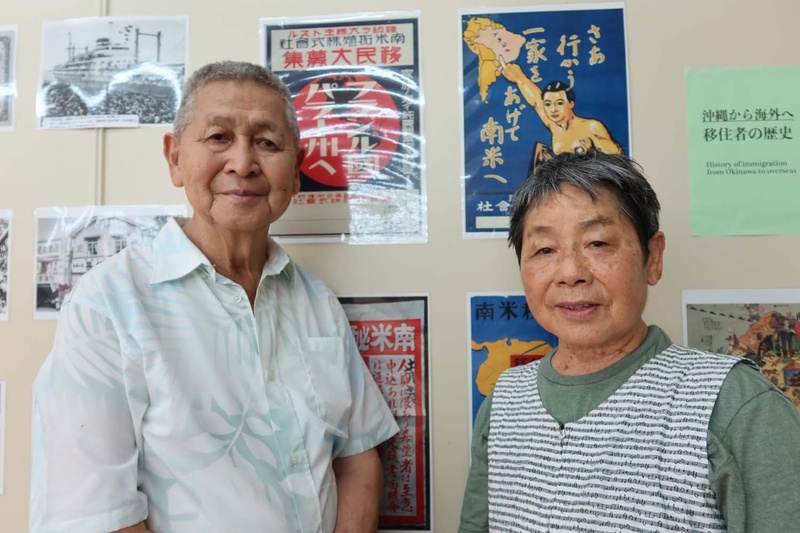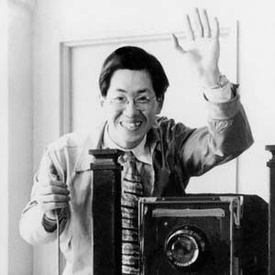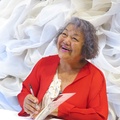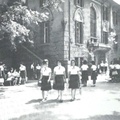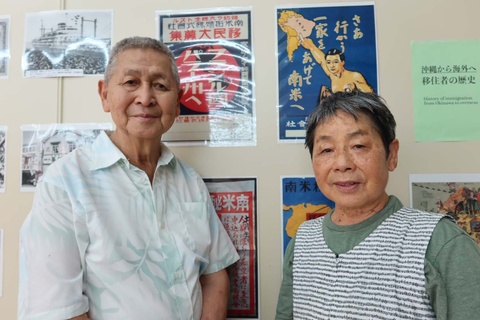
On November 3rd during the 7th Worldwide Uchinanchu Festival, the "Nahato Comes to Machigwa: Global Uchinanchu and Machigwa Exhibition" was being held at the former Zakkabu section of Heiwa-dori Shopping Arcade in Naha City. I spoke to an elderly Japanese couple who were intently looking at the Brazilian immigrant exhibit, and it turned out they were former Brazilian immigrants.
"You're a reporter for a Japanese-language newspaper from Brazil? I used to be a cameraman for Jornal do Brasil. Nakazawa Koichi from Atibaia is my amigo," says Higuchi Kaoru (89 years old, born in the Philippines) with a nostalgic smile.
He currently lives in Los Angeles, California, U.S.A. While the nursing home he lives in is undergoing renovations for two weeks, he decided to take a sightseeing trip to Japan and take a look at the Worldwide Uchinanchu Festival.
"I came to Brazil on the first immigrant ship after the war," so that must have been 1953. His father was the eighth son and emigrated to the Philippines before the war. Higuchi was born in Manila. His father was killed during the war. When Japan lost the war, he fled into the mountains with other Japanese, but was taken in by American soldiers and returned to Japan.
He spent eight years in his parents' hometown of Fukushima Prefecture. "It was cramped. If we did anything conspicuous, it would cause a fuss. It was noisy all around," he recalls. "I was working at the prefectural office at the time. But when I heard that immigration to Brazil was being resumed, my mother decided to take my six siblings and I and move there, and we were the first to board the first immigrant ship."
She got off in Rio and spent 18 years there. She spent the first three years as an agricultural contract migrant in the rural Japuiba area, before moving to Rio city. "I was hired as a maid at a wealthy man's house. He said he was going to have a party, so I took some pictures with my Yashica camera and gave them as a present, and he really liked them. During the war, my older brother helped a photojournalist and developed the films in the bathroom at home. I saw him do that, so I copied him," she says with a laugh.
"My patron (employer) showed the photo to his friend, the president of the newspaper 'Jornal de Noticia,' and he asked me if I wanted to work for him as a photographer. I was lucky." Then, "while I was working there, I was poached by 'Jornal do Brasil.' In 1954, a major building fire broke out in Rio, and the president of the newspaper liked my photos and became fond of me." It's the very definition of an immigrant success story.
Jun Miki introduces Nikon to Brazil
In 1958, Jun Miki, a representative Japanese photojournalist, came to Brazil to mark the 50th anniversary of Japanese immigration to Brazil. He was the only Japanese person to work as a regular photographer for Life magazine (published by Time-Life Inc. in the United States) immediately after the end of the war. He had traveled around the world introducing Nikon lenses and cameras made in Japan, and in Rio he also sold them to the presidents of newspaper companies.
Higuchi shared an amazing story, saying, "It was Miki who brought Nikon to Brazil. The president of Jornal do Brasil liked Nikon and said to me, 'You're Japanese, so you can do it. Learn how to repair it.' So I went all the way to Japan and learned how to repair Nikon cameras and came back to Japan."
However, in 1971, they decided to move to Los Angeles, where his uncle lived. His wife, Masako (82, originally from Fukushima Prefecture), explains, "When we thought about what our three children would be like when they grew up, we thought it would be safer to live in Los Angeles, where all our relatives were."
Masako happened to be on the same ship as Higuchi's sister when she emigrated to Brazil in 1958. That's how they met and got married.
At the time, Higuchi had zero English conversation skills, but he recalls, "I learned in Brazil that when communicating with people, it's more important to try to convey your feelings than to try to use the right words. So I thought I'd be able to manage in America."
His former colleague is the famous Evandro Teixeira.

He continued to work as a camera repairman in Los Angeles and raised his children. He has been living in Los Angeles for 51 years now. During that time, he visited Brazil about four times to meet with his former cameraman colleague from his time at Jornal do Brasil, Evandro Teixeira , who is now a famous cameraman affiliated with the Moreira Salles Institute.
"South America is more passionate than America. America is individualistic, and it's even difficult for parents to convey their feelings to their children. But at the pre-party parade, the Okinawans called out to these people of Okinawan descent from America, saying 'Welcome home,' as if they were family. I think that's amazing," he said.
"I was forced to give up my Japanese citizenship in order to come to Japan," said Masako sadly. "Don't you think that's so unfair?" I learned that she had dual nationality because she also had American citizenship.
The Japanese Consulate General insisted that "dual citizenship is not recognized, so please choose one." She chose American citizenship as a priority to live in America where her relatives and children live, and reluctantly renounced her Japanese citizenship in order to go to Japan. "Japanese government offices are inflexible, aren't they?" she tweeted.
Finally, Higuchi laughed and said, "My children were raised in America, but they are Cariocas (Rio natives)."
© 2023 Masayuki Fukasawa


